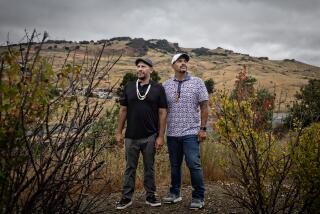Residents ‘Pillaging and Sacking San Juan County for 100 Years’ : Pothunters Resent Enforcement of Federal Law
BLANDING, Utah — Locals like to joke that the Blanding town dump is fast becoming America’s richest archeological ruin.
The dump’s rumored bounty can be traced to a spring morning when federal agents raided some of this remote county’s most respectable homes and carted away boxfuls of Indian artifacts from bookshelves, basements and mantles.
From around the time of Christ until AD 1300, the Anasazi people made their homes in the Four Corners region where Utah, New Mexico, Colorado and Arizona meet in a collage of wind-carved canyon, desert sage and majestic forest.
Still hidden in buried pueblos, dry caves and cliff dwellings are the treasures of their lost civilization, which was thought to number around 100,000, about 30 times the population of Blanding.
For generations, local families, archeologists and occasional outsiders have combed the ruins for the beautiful pottery, jewelry and other souvenirs of the Anasazi.
“Like a big Easter-egg hunt,” said Winston Hurst, curator of the Edge of the Cedars Museum in Blanding.
The fun ended last May 8 when law and tradition collided in the Four Corners.
In the first major enforcement of the 1979 Archeological Resources Protection Act, authorities confiscated more than 300 artifacts from 17 homes and trading posts in San Juan County, Utah, and nearby Grants County, Colo.
The artifacts were thought to have been plundered from sites on public land, a crime punishable by up to a year in jail and $10,000 in fines. The same objects, if taken from private land, would legally belong to the digger.
Among the eight homes raided were those of two of San Juan County’s three commissioners. The mayor’s brother was also targeted, and the mayor himself angrily threatened to have Blanding secede from the union.
Sentiment here still swings from outrage to paranoia.
“How can I be sure you’re not a fed?” one resident asked a reporter.
Rumors are rife about panicky people throwing away precious artifacts or reburying them in dread of another raid. Three civil suits have been filed by owners demanding the return of confiscated artifacts.
Nearly seven months after the raid, no indictments had been handed down. Sixty artifacts have been returned for lack of proof that they came from public land, according to Brent Ward, the U.S. attorney in Utah who coordinated the operation.
One Blanding homeowner was acquitted in a separate pothunting case, raising questions about the credibility of informant Earl Shumway, a convicted burglar and admitted commercial pothunter.
But Ward and local authorities said the raid has deterred pothunters, who have damaged or destroyed perhaps 80% of the area’s sites.
Pete Steele, a Bureau of Land Management ranger, said a few prominent Blanding families “have been pillaging and sacking San Juan County for 100 years. They think it’s their right.”
The pothunting tradition here goes back to the turn of the century. But hobby turned to frenzy in the Depression, when the University of Utah paid for pots to build up its museum collection.
Blanding’s general store used to swap a candy bar or pack of gum for an arrowhead. And, like many local children, Devar Shumway learned early how to spot ruins and excavate them.
Devar Shumway speculated that practically every home in Blanding boasted a few artifacts obtained by pothunters. “But after the raid, it all disappeared,” he said. “I know people who are taking it out to the trash dump.”
His son Casey was the first person prosecuted under the archeology-protection act. He was fined $700 and placed on probation in 1980.
Casey Shumway still digs at least three times a week--on private land only, he insists--and keeps museum display cases in his home to show off his finds.
“A really nice bowl might be worth $200, but it takes a month of searching and digging,” he said. He believes the archeological fruits of San Juan County are too plentiful to ever disappear.
“It’s like a buried city,” he said, “as if L.A. crumbled and was covered with sagebrush.”
More to Read
Sign up for Essential California
The most important California stories and recommendations in your inbox every morning.
You may occasionally receive promotional content from the Los Angeles Times.










